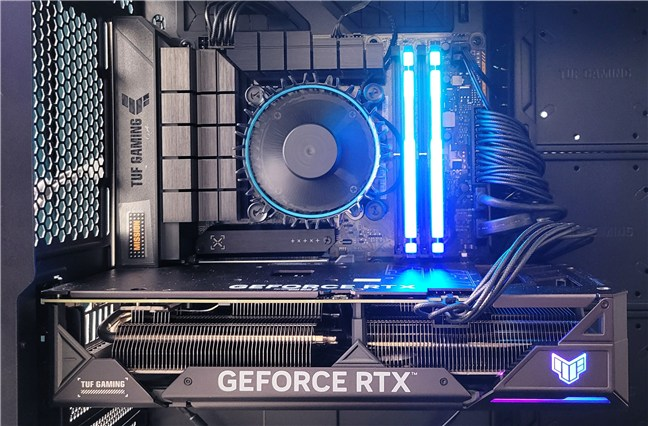What to expect from an entry-level gaming PC Powered by ASUS

I recently had the opportunity to test a gaming computer Powered by ASUS. It is an entry-level system that aims to be a good choice for both gaming and everyday computer activities. The local retailer that sent it to me designed it for people who want to enjoy balanced performance without spending exorbitant amounts of money. Its hardware configuration is well-balanced, its case has a modern and pleasant design, and the price is moderate. If you’re looking for such a computer and want to know what to expect, here’s what my experience has been:
Using an entry-level gaming PC
First of all, I have to tell you about the configuration of the gaming PC I’m discussing in this article. To me, it seems to be a balanced one that can offer a mix of performance and reliability to meet the needs of users on a budget.

Playing Star Wars Outlaws on an entry-level gaming PC
The computer I used includes the following components:
- Processor: Intel Core i5-14500. It’s a powerful mid-range processor, ideal for casual gaming. It has 14 cores (six for performance and eight for efficiency) and 20 threads. The maximum turbo frequency is 5 GHz for the performance cores and 3.7 GHz for the efficient cores. It’s obviously capable of handling multiple tasks smoothly, thanks to its efficient architecture.
- Motherboard: ASUS TUF GAMING B760M-PLUS. The motherboard supports DDR5 memory, PCIe 4.0, and has multiple USB ports, as well as 2.5 Gbps Ethernet and high-quality audio outputs. This motherboard is built for the latest Intel processors and promises to deliver solid performance for intense gaming sessions.
- RAM: Kingston Fury Beast 16 GB DDR5 running at 6000 MT/s. It’s a fast memory that lets you run multiple applications simultaneously, ensuring smooth transitions between tasks.
- Storage: 1TB Seagate Barracuda Q5 M.2 PCIe 3.0 SSD. With fast access times, this SSD reduces load times for games and applications while also offering generous storage space.
- Video card: ASUS TUF Gaming GeForce RTX 4060 Ti 8GB GDDR6 OC Edition. With good gaming performance in 1080p resolutions, this video card supports ray tracing and DLSS 3, adding an extra layer of graphical realism.
- PSU: ASUS ROG Strix Aura 850W. A reliable, 80 Plus GOLD-certified power supply capable of supporting all system components.
- Case: ASUS TUF GAMING GT502. Its modern design includes transparent side panels, optimized ventilation, and room for future upgrades.


The hardware configuration is decent for gaming
One of the key aspects of an entry-level PC is to provide a smooth user and gaming experience. It’s obvious that while it could never compete with a high-end system, it won’t cost a fortune either. And that’s exactly what the Evo Warship is designed to do: deliver enough performance to enjoy modern games at decent settings, while still performing admirably in day-to-day activities. Its hardware configuration is just right for those who are looking to enter the world of computer gaming but want to stay within a somewhat reasonable budget.
I had the opportunity to use this PC every day for a couple of weeks and was thus able to test it in several scenarios. When it comes to gaming, I played Indiana Jones and the Great Circle and Star Wars Outlaws. Meanwhile, I’ve finished the first one and I recommend it to all Indy fans, but also to anyone who appreciates a well-crafted adventure. I’m still playing the second game and, although I’m not a big Star Wars fan, I have to admit that I quite like it. Both games ran at 1080p resolution, medium to high settings, at a constant framerate of over 60 fps (frames per second). My experience in these games was a quality one, as the NVIDIA GeForce RTX 4060 Ti video card was capable of detailed graphics. In addition, I also found the special effects and lighting in complex environments to be rendered with decent clarity. By the way, if you want more details about playing Indiana Jones and the Great Circle on this computer, I wrote this article about my experience.


Playing Indiana Jones and the Great Circle
In addition to gaming, any entry-level gaming PC, including this one Powered by ASUS, should be great for everyday activities. Why do I mention that? Because a PC that can run today’s games has not just enough, but more than enough computing power to run any typical task. I can tell you that I’ve used it for writing articles, had at least a few dozen tabs running in the browser almost constantly, and worked in parallel with Microsoft Word and Google Docs. Oh, and lest I forget: I never turn off the music playing on YouTube. 🙂 All this ran smoothly on the computer I tested, and its performance was very good, with no latency or crashes to distract my focus. You can also seamlessly run virtual machines performing various tests, do software development, or some photo/video editing at a decent level.


Everyday activities on this entry-level gaming PC
After testing it, I can say that an entry-level gaming computer like this one, aimed at budget gamers and users looking for a balanced system, is a good choice for students. It’s also a solid option for people who don’t want to invest in a high-end system, as well as for those who want a reliable PC for general use. Moreover, it seems to be a good choice for families who need a computer that can be used by multiple users, each with their own interests and needs.
Are you planning to buy an entry-level gaming PC?
An entry-level gaming computer, like the one I’ve been using, can offer a good balance between performance and price. With hardware capable enough to run modern games as well as any everyday activity, this PC is a good choice for less demanding users. Are you planning to buy a similar computer? Is it for you or a family member with a passion for gaming? Let me know in the comments below what you think: Is it worth investing in an entry-level gaming PC, or are you better off saving up for something even more powerful?
Source link






